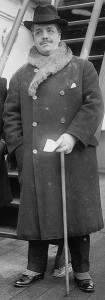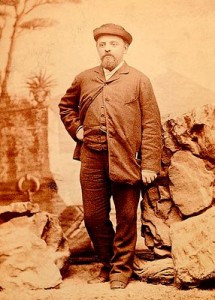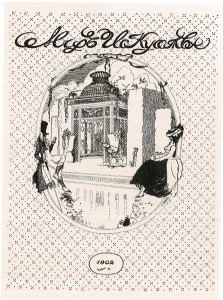Emerging from Tsarist Russia and the turbulent early years of the twentieth century, the Ballet Russes was a hugely influential and revolutionary era in the arts that altered the interactions of art, music and dance for generations to follow. The ballet troupe lasted from 1909 to 1929 when the impresario Serge Diaghilev unexpectedly died. In order to fully grasp the movement created by Diaghilev it is essential to have a clear understanding of its origins and the motivations behind what became such a diverse array of talents. This combination gave rise to the colorful and impactful first modern ballet company of the twentieth century: the Ballet Russes. ((Robert C. Hansen, Scenic and Costume Design for the Ballet Russes (Ann Arbor, Michigan: UMI Research Press, 1985), 1-2.))
Many factors lead to the rise of the Ballet Russes and Russian society at the time to allow its acceptance of an artistic movement. The abolition of serfdom in the 1860’s led to the rise of the bourgeoisie, and the so-called “silver age” in Russia when nationalism and internationalism sentiments were cultivated through the arts. ((Ibid., 1.)) The two historical capitols of Russia, Moscow and Saint Petersburg, developed and influenced separately because of their geography. While the historical Russian capitol, Moscow, was then viewed as antiquated, its distance from the controlling influence of the tsar’s imperial courts of Saint Petersburg allowed for greater freedom in the development of nationalism and the avant-garde movement. ((Ibid)) Petersburg was known in Russia at the time as the window to the west and a European city because it was modeled after Versailles, and thus became a center for international arts and ideas. ((Ibid., 2.)) As the imperial courts and the tsar resided in Petersburg, the imperial artists directly monitored the development of arts and artistic movements with little variation.
Originally in Petersburg to pursue a law degree, Serge Diaghilev began integrating himself into the artistic community. Diaghilev would singlehandedly become the most influential artistic director in Russia through his eventual orchestrate the direction of the Ballet Russes. At school, Diaghilev joined a band of art lovers comprised of Alexandre Benois, Walter Nouvel, Dima Filosofov, Constantine Somov and Leon Bakst. ((Anna Winestein, “Quiet Revolutionaries: The ‘Mir Iskusstva’ Movement and Russian Design,” Journal of Design History 21, no. 4 (2008): 315.)) Calling themselves the Nevsky Pickwickians, their mission was to discuss the arts and “ideas for an artistic society” which they strove to synthesize. ((Ibid., 316.)) The Pickwickians were one among multiple social artistic circles; another of the time was the Mamontov art circle. ((Lynn Garafola, Diaghilev’s Ballet Russes (New York: Oxford University Press, 1989), 151.))

Diaghilev, Courtesy of wikicommons. ((available at https://commons.wikimedia.org/wiki/File:Sergei_Diaghilev_02.jpg))
Although Diaghilev is often credited with the creation of diverse artistic groups in Russia, Savva Ivanovich Mamontov, one of Russia’s original premiere patrons of the arts in the late 1800s played a hugely influential role. Mamontov was able to support artistic endeavors through his wealth accumulated in investment in the Russian railroads. ((Lynn Garafola, Diaghilev’s Ballet Russes,150; Hansen, 4.)) Centered in his estate at Abramtzevo, Mamontov’s Art circle created the first private opera company. ((Hansen, 4.)) The synthesis of artists, costume designers and performers was the first such merger of art forms never before achieved in Russia or in the Western world. ((Garafola, Diaghilev’s Ballet Russes, 151)) Although the creation of the Mamontov Art circle was revolutionary, the results achieved were scattered and criticized because they suffered from a lack of cohesion among the disparate elements, and eventually this was the downfall of the private opera company. ((Ibid))

Savva Mamontov, Courtesy of wikicommons ((available at https://commons.wikimedia.org/wiki/File:Savva_Mamontov.jpg))

Abramtzevo, courtesy of wiki commons ((available at https://commons.wikimedia.org/wiki/File:The_house-manor_Abramtzevo_(3863825455).jpg))
Diaghilev was aware of Mamontov’s artistic experiments at Abramtzevo, and first became acquainted with Mamontov at an art exhibition which he had organized in Saint Petersburg. Diaghilev and the Pickwickians were so taken by the unique combinations of Mamontov, that the group quickly thereafter formalized their admiration of art in the formation of Mir Iskusstva (World of Art), an arts magazine evaluating everything from music, art, and performances. Hence, the magazine transitioned their social society into a “semi-professional, public enterprise” with the financial support of Mamontov and other art enthusiasts. ((Ibid)) Under Diaghilev’s leadership and direction Mir Iskusstva flourished, due to the aversion of sectarian causes, and rediscovery of Russia’s artistic heritage. ((Hansen, 9-10.))
Among Diaghilev’s innovations was to promote the finest associations of artists, choreographers and composers. Cut off from Russia after the war and Soviet revolution, he orchestrated ground-breaking artistic collaborations among young choreographers, composers, designers, and dancers, all at the forefront of their several fields. ((Garafola, Diaghilev’s Ballet Russes, 199)) This included Paris-based artists Pablo Picasso, André Derain, Henri Matisse, Georges Rouault, Georges Braque, Giorgio de Chirico and Chanel to design for his productions. ((Hansen, 1-15)) Although most of his original company were resident performers at the Imperial Ballet of Saint Petersburg, Diaghilev hired them to perform in Paris during the Imperial Ballet’s summer holidays. ((Diaghilev and the Ballet Russes, produced by the National Gallery of Art (2013), DVD.)) The Ballets Russes was based in Paris and performed throughout Europe and on tours to North and South America. ((Hansen, 333)) The company never performed in Russia, where the Revolution disrupted society. After its initial Paris season, the company had no formal ties there. Noteworthy to Diaghilev’s artistic achievements in revolutionizing the then 400-year old art of ballet is the political backdrop of the times: Russian revolutions of 1905 and 1917 and World War I. Despite the dangers of travel and bitter European rivalries, art not only prevailed but flourished.

Cover of Mir Iskusstva by Leon Bakst in 1902. ((Leon Bakst, Léon Bakst: Set and Costume Designs, Book Illustrations, Paintings and Graphic Works, Comp. Irina Nikolaevna Pruzhan, (Harmondsworth, Middlesex, England: Viking, 1987), 97))
Part 2: http://blogs.dickinson.edu/quallsk/2016/05/03/leon-bakst-and-scheherazade-part-2-of-5/
Part 3: http://blogs.dickinson.edu/quallsk/2016/05/03/the-loss-of-gesamtkunstwerk-part-3-of-5/
Part 4: http://blogs.dickinson.edu/quallsk/2016/05/03/images-of-the-ballet-russes-part-4-of-5/
Part 5 (bibliography): http://blogs.dickinson.edu/quallsk/2016/05/03/original-proposal-and-bibliography-part-5-of-5/
